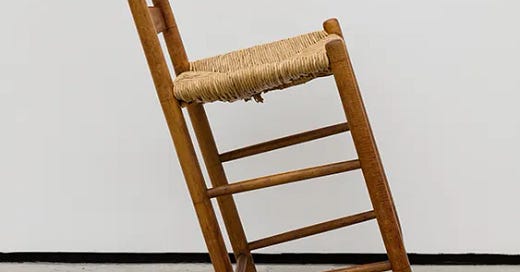Hello and happy Monday! I’m mixing up the format this week to bring you a bonus edition with five more ideas about design from the Design Lobster archives. I hope they help you see things with new eyes this week 👀
You can read the previous five ideas I shared here. Enjoy!
✨Enjoying Design Lobster? Please share it with a friend, colleague or fellow designer.
1. Embrace ugliness

Many of you might already be following Ugly Design on instagram, where Jonas Nyffenegger and Sébastien Mathys document all manner of bafflingly hideous products. The misshapen and disconcertingly anatomical feature prominently (see the mug above) along with objects so abjectly odd, unappealing or downright nasty that it is mystifying why they were ever made at all.
Nowadays, the cool simplicity exemplified by Apple devices pervades the mainstream of design culture. Paradoxically, it might be that in this historic moment the products which now stand out are the ones which go against this grain by being odd, discordant or even slightly repulsive. In an ever more airbrushed age, my advice is to embrace your ugly!
🤨 Gross out on the Ugly Design instagram
2. Let people feel it
The Danish explorer Gustav Holm commissioned these remarkable driftwood objects from the Tunumiit people of Eastern Greenland in the 1880s. Each one is carved to represent a different part of the Greenland coast, with the central thinner example representing an island chain and the squatter one to the right a coastline. The notches and grooves form a tactile diagram of the landscape and would have been used like a map by Holm to navigate the territory. Unlike paper maps they do not use cardinal directions and are designed to be read (or felt) in a continuous loop, up one side and down the other. In this sense they are more like the record of a journey than a map.
Not only do these objects stretch the definition of what a map can be, but they remind us how neglected the non-visual senses are in most design. If you can engage people to feel your design with more than one sense, you’ll have an immeasurably deeper impact on how they feel about it overall.
📖 Juhani Pallasmaa wrote the definitive book on sensory architectural design - The Eyes of the Skin
3. Be skeptical of averages
In the early 1950’s, after a spate of fatal accidents, an anthropologist called Lt Gilbert Daniels was invited by the US Air Force to carry out an anthropometric study. The US Air Force believed the average size of pilots had changed since the 20’s when the cockpits were first designed, resulting in the increasing number of accidents.
Daniel’s carried out an anthropometric study of 4,000 pilots – measuring them across 10 key dimensions, from their waist size, to the distance between their eyes. Contrary to the military’s expectations, he discovered was that the averages of these measurements described a body shape that almost no individual pilot actually had. Across the 10 key dimensions, there was nobody who was within the average range for all of them. The ‘average pilot’ did not exist. All those accidents stemmed from design choices in the cockpit based on this one wrong assumption.
The solution was to design the cockpit for individual fit rather than an average. By making seats, pedals and and controls adjustable, each pilot could alter the layout so that it suited their body. Individual fit is a simple idea, but it forces us to reconsider how we might be misusing averages in our own designs. So the next time you find yourself talking about an “average” user, check yourself and dig back into who you’re really referring to.
⚖️ Here’s the always-interesting Rory Sutherland talking about averages
4. Celebrate gestures
The United Society of Believers in Christ's Second Appearing are a millenarian Chrisitan sect originally founded in 1747 in the North of England but which later moved to the United States. They are colloquially known as the Shakers – a reference to their ecstatic behaviour during worship. Shaker communities are notable for designing their buildings and furnishings with great care, considering craftsmanship to be a kind of prayer.
This Shaker chair, designed by George O'Donnell in 1852, has a tiny metal ball and socket mechanism in the back two legs to allow a sitter to lean back without scratching the floor or damaging the chair. An almost invisible change, it nevertheless transforms the experience of sitting – dignifying and accommodating the desire many of us have to lean back whilst seated. How could you celebrate an instinctive behaviour like this in your design?
🪑 Go down a Shaker furniture rabbit hole
5. Shift the whole system
The Kings Cross area of Sydney is well-known historically for its colourful nightlife, but a rising number of violent crimes in the early 2010’s, including scary “one punch” attacks, led to the implementation of the so called Lockout Laws in 2014. These mandated stricter regulations around the sale of alcohol and closing times, and were accompanied by a heavier police presence in certain areas. Though effective at reducing anti-social behaviour, these measures came at a heavy cost to the viability of night-time venues and there was evidence that violence had just been transferred elsewhere.
Around this time, Kees Dorst and their team at the Designing Out Crime Research Centre were invited to explore alternative ways of reducing violent crime in Kings Cross. They observed the way that closing times resulted in huge numbers of people being discharged onto the narrow pavements with nowhere to sit, few toilet facilities and no public transport options besides an hour-long taxi queue. A recipe for frustration and tension.
In a leap of imagination, they reframed the problem instead as how to make Kings Cross “the best music festival in the world” – proposing food stalls, street entertainers, toilet facilities and better public transport options to promote a process of “unconscious sobering” among patrons leaving clubs and bars.
Though yet to be implemented, this project remains a great example nonetheless of the power of design to reframe a problem based on careful observation. Whatever the scale of the project you are working on, think carefully about the system it is embedded in and the opportunities there might be to nudge it in a different, better direction.
🌎 Geek out on system-shifting design techniques
Thanks for reading this special edition of Design Lobster. Hope you have an excellent week,
Ben 🦞
Enjoyed this week’s issue? Let me know by clicking the heart button.
👇








Wonderful edition of Design Lobster this week!
Celebrate complexity?
Our kids don’t need the quantum insults of Sesame Street to understand.
“One of these things is not like the other, one of these things is not the same.”
Complexity in design is a hallmark of a more intelligent culture.